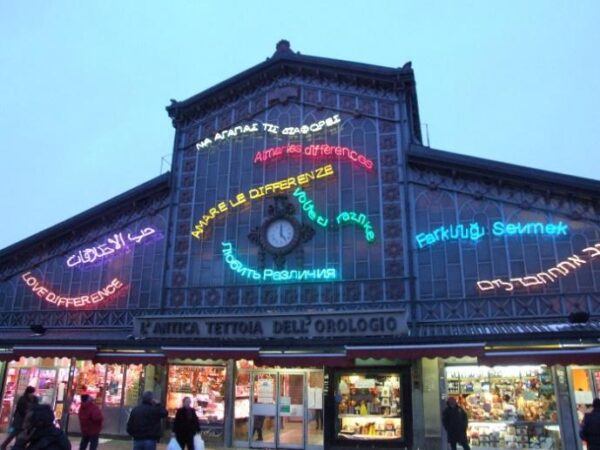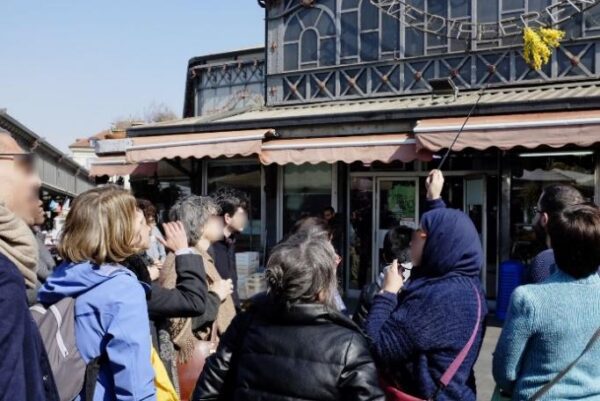Migrantour: intercultural urban walks
« Passion Lives Here” was the slogan of the 2006 Turin Olympic Games. That passion lives in Turin, is clear from the eyes of the Torinese when you talk to them about anything born in the shadow of the Mole, such as fashion, cinema or cars. In this case, however, we are happy and proud that the project “Torino Migranda” has become the launchpad for a network of international urban intercultural tours led by migrants; that is, Migrantour! It was no accident this all started in Turin: where else can you find another city with a market like Porta Palazzo, where you can find absolutely anything and hear more than 60 different languages and dialects from across the world on a daily basis?! [….] A missed opportunity for an encounter that Migrantour has now made possible: responsible, lowcost and environmentally-friendly tourism at kilometre zero. So let’s get started! » (Migrantour website)
With these words, the official website presents the Migrantour project. It was born in Turin in 2009 from the idea of an anthropologist partnering with the responsible tourism tour operator Viaggi Solidali’ and, within a little more than a decade, it expanded to 20 other European cities. The particularity of Migrantour is to give people with a migrant background the opportunity to be trained as ‘intercultural companions’- who are not tourist guides since they do not have an official license – to guide tourists to multicultural neighborhoods. The basic idea is to allow migrants to «acquire the right to represent themselves rather than be represented» (Vietti, 2015, 10) and to deconstruct racist stereotypes, reversing the stigma related to them.
discovery, inclusiveness, truly intercultural encounters, and authentic world tours are the keywords with which this project presents itself to tourists. The world that it invites to discover is not that of a distant land but the ‘world within our cities’ with all the characteristics to know the ‘Other’: the migrant in multi-ethnic neighborhoods.
Porta Palazzo Market: the stage of multiculturalism
Porta Palazzo, Porta Pila, Bab al-Kssar, Adjamé marché are just some of the many names given in different languages to this square! Porta Palazzo is the largest market in Europe and takes place every morning, a few hundred metres from Piazza Castello in the heart of Turin. It is a treasure trove of faces, smells, images and sensations: cross a road and you pass through Asia, Africa and South America. You will discover flavours and foods of the world, hearing directly from the people that share its origins.
(Migrantour website)
The Porta Palazzo area spreads around Piazza della Repubblica, which hosts one of the largest markets in Europe. Although it is close to the city center, in the collective imagination it is not associated with it: some call it a ‘periphery of the center’ or the ‘center of the peripheries’ while in the words of the former mayor of Turin, it is configured as an ‘existential periphery’. Throughout the 20th century, it has been a place of first landing for immigrants who moved to Turin from neighboring regions and southern Italy for work. Today it welcomes migrants from non-European countries and many inhabitants and frequenters of the area, as well as entrepreneurs and market vendors, are foreigners. In recent decades, the area has been the focus of several regeneration projects that have triggered gentrification and touristification processes. Among the most recent are the opening of the Mercato Centrale, a quality food hub, and the Combo Hostel with about 200 beds, a bar, restaurant, and exhibition spaces.
As the creator of the Migrantour project explained to me1 :
Our project is also touristic, it is mainly touristic. There are elements in Porta Palazzo that concern the fruition of the territory from its aesthetic qualities, accessibility, distance, and the density of elements that can be enhanced within an experience that, although committed, social and responsible, remains a tourist experience. […] So, the choice of places is always towards complex territories, which have problematic, difficult dimensions, to deconstruct the stereotype and the stigmatizing narrative that often emerges from these problems, but at the same time, they have elements on which tourism can be done, dimensions that can be enhanced. We don’t want to do slumming or poverty tourism…. […] There is this repulsive and fascinating mixture of the exotic, and Porta Palazzo has this nuance that other neighborhoods do not have. (Migrantour coordinator, Interview, March 2019).
Porta Palazzo thus represents the stage of multiculturalism and cultural diversity, which is both repulsive and fascinating. The quintessential symbol of this diversity is an art installation of lights on the covered market that becomes an attraction: a sign symbolizing the multiculturalism of Porta Palazzo and its market. Photographed by tourists, included in flyers and guidebooks and pointed out by tourist guides, it in turn becomes an indicator of multiculturalism. « Loving Differences, » written in 39 different languages, reminds tourists to discover the different cultures of the ‘world within the city’ (figg 1-2).
Cultures and migrants for tourists’ consumption
In about two hours, the standard length of the walks, the guides aim to explain to tourists 5 cultures of 5 peoples: the Chinese, Latin Americans, Southerner Italians, Moroccans, and Romanians – each corresponding to a section of the market – outlining the migratory waves that layer the life of Porta Palazzo. Participating in the walks as an ethnographer, some questions crowded into my mind: Is the right to represent oneself and one culture compatible with the representation of other supposed cultures? How can one talk about all these ‘cultures’ in such a brief time and in that vast and complex space, between a Chinese farmers’ stand and a halal butcher shop?
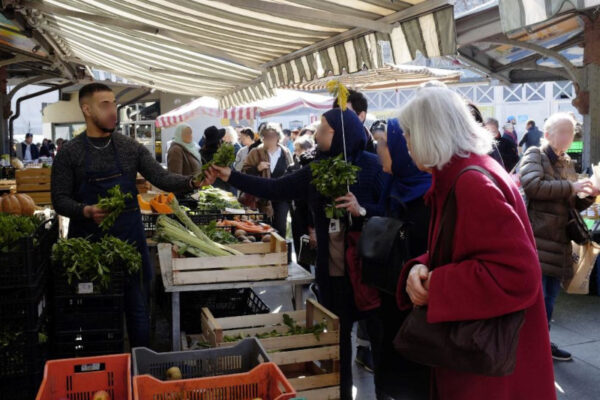
Credits. Sara Iandolo (March 2019)
In the guides’ discourses, cultural stereotypes are continually produced and reproduced at the very moment they try to refute and deconstruct them. Cultures are strategically packaged and essentialized to be discovered and consumed by tourists. The Migrantour project coordinator calls this ‘strategic essentialism’, used to manage and make intercultural encounters acceptable for tour guides and tourists (Vietti, 2015). Moreover, during the tours, cultures are materialized into visible entities: objects, foods or people that mark them.
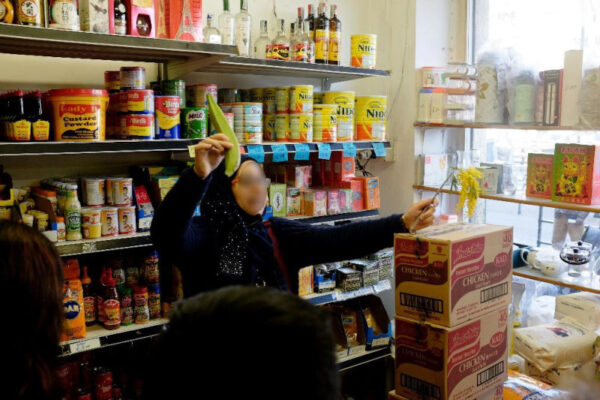
Credits. Sara Iandolo (March 2019)
Thus, guides take tourists in pursuit of the Moroccan language or the Southern Italian vendor by showing exotic products, which often are experienced by participants not only through the gaze but also through their other senses, such as touch and taste. Food becomes a souvenir that tourists buy as a reminder of their trip and, »being the most tactile, tasty, sniffable form by which the Other offers itself to the tourist (d’Eramo 2017, 189), the act of tasting food is the main way to taste another culture »(ibid., 190).
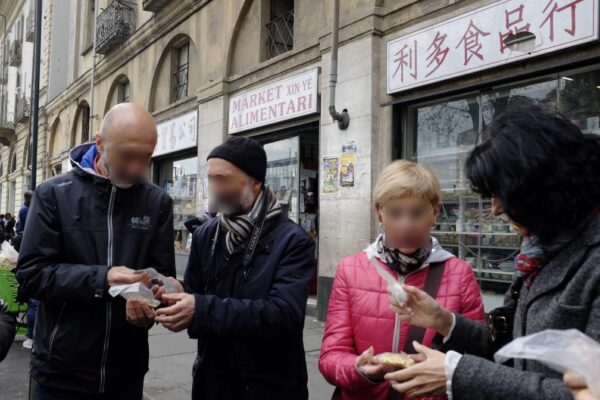
Credits. Sara Iandolo (March 2019)
We stop in front of the Oriental Market. I feel awkward about my positioning in the space and at the same time I am overthinking: we – the tourists – are all white, clustered around our guide, while in front of us are seated many black people (mostly women), conversing, selling some products and looking at us. At the same time, we look at them. A tourist asks the guide: « What are these black people doing sitting here? ». Black peoplebecome the object of our interest and gaze, like the exotic products in the small bags that the intercultural guide continually shows us (Fieldnote, October 2018).
What surprises tourists is the constant discovery of cultures, but also of ‘natives’, vendors or passersby who are there to witness multiculturalism. The ‘natives’, even those not questioned in the planned itinerary, thus possess a high symbolic yield (Corbillé, 2009) and constitute an important element of the tourist device. Migration and migrants are the focus of decades-long debates: stigmatized and racist discourses and practices, but also sympathetic, humanitarian and welcoming sentiments and initiatives contributed to constructing them as actual attractions, objects of curiosity by locals. Using the words of sociologist Dean MacCannell (1976), attraction is the result of a production process that involves the entire society. In this context, the guides, to present themselves and other migrants in an acceptable way to tourists, use narratives and stories of successful migration paths, describing migrants as workers and entrepreneurs who contribute to the economic development of Italy and the Porta Palazzo market. In a society that hardly welcomes the presence of migrants, accepting them at best only when they are useful arms for low-cost labor, presenting themselves as productive and hard-working becomes a concrete legitimization of their presence. However, the risk of this narrative is to propose a further division: the one between migrants ‘for good’, willing and productive, and ‘for bad’, undeserving, idle, and profiteering (Iandolo, 2021).
And one more question came to my mind: how does the guided tour deal with the white gaze of the tourist that recalls the memory of colonization, white privilege, and class inequality? Some guides manage to include discourses in the tours that seek to articulate the complexity of the political relationship between State, violence and migration. However, the inclusion of such discourses is a prerogative of the individual guide and depends on his or her habitus, rather than representing a focus of the project. Economic inequalities and class differences are not thematized by the guides, who sometimes tend to ethnicize poverty and confuse it in the great cauldron of cultural diversity.
Through the Migrantour walk, cultural diversity is thus produced by guides and consumed by tourists in its commodity form. It is pacified and domesticated, staged but also acted upon, and tamed from features conceived as negative or conflicting. The walks are frequented not only by tourists but also by some new residents, animated by a sort of civic activism, interested in promoting and enhancing the neighborhood in its multicultural soul. The moment of discovery of otherness is indeed a central element in the processes of gentrification (Bolzoni, 2021) but also big investors of the area capitalize on this brand of diversity. As we read on the Combo Hostel website:
The loft-like architecture plays host to a hostel, a bar-restaurant, a radio station, and an event space. Perhaps we were also inspired by the burst of spice that is Europe’s largest, multi-ethnic market […] So, our kitchen is inspired by a multitude of tastes and flavors, from the spices of North Africa to the sharp freshness of South-East Asian cuisine. (Combo Hostel website)
In this way, tourists and residents mirror each other, becoming more and more alike (Rabbiosi, 2016) ready to consume Porta Palazzo touristically in that journey into the diversity that Migrantour proposes.
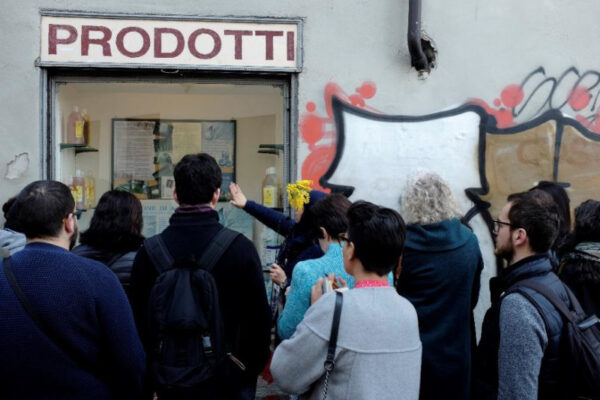
Credits. Sara Iandolo (March 2019)
References
- Bolzoni, M. (2021). The Diversity That We Love. Commodification and Control of Diversity in Gentrifying Neighbourhoods. Italian Sociological Review, 12 (2), 435-457.
- Corbillé, S. (2009). Tourisme, diversité enchantée et rapports symboliques dans les quartiers gentrifiés du nord -est de Paris. Genèses 76, 30-51.
- D’Eramo, M. (2017). Il selfie del mondo. Indagine sull’età del turismo. Feltrinelli Editore, Milano.
- Iandolo, S. (2021), Esperire l’alterità. ‘Migrantour’ tra turismo e riqualificazione, Antropologia Pubblica, 7(1), 203-214.
- MacCannell D. (1976). The tourist. A new theory of the leisure class, Schocken books; ed. 1999 University of California press, Berkley, Los Angeles, London
- Rabbiosi, C. (2016). Il turismo partecipativo a Milano. Un’analisi critica di due iniziative, Tourism Review, https://doi.org/10.4000/viatourism.300
- Vietti, F. (2015). The world within cities. Intercultural walks in Florence, Genoa, Lisbon, Marseille, Milan, Paris, Rome, Turin and Valencia. New Press, Como.
Sources
AUTEURS
DATE
Janvier 2024
CATÉGORIE
Turin
CITER LA NOTICE
